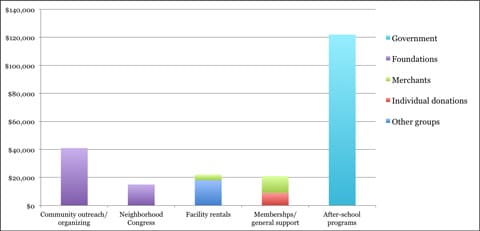Organizing the Board to Support Nonprofit Revenue Strategy
Think more broadly (and effectively) about how board members can support the key aspects of your nonprofit revenue strategy.

Don’t focus only on how board members can raise individual donations (or not!)
But instead, think more broadly (and effectively) about how board members can support the key aspects of your nonprofit revenue strategy:
In the quest for funds, there is no shortage of advice given to nonprofits. Start a social enterprise! Get corporate donations! Raffle a house! Perhaps the most frequent and consistent advice: focus the board on getting major gifts; in fact, recruit a strong fundraising board that can get major gifts.
But pursuing a new funding stream for which you may not have the right people and competencies already is usually not the best place to start. Instead, we recommend that you see how you can boost and leverage the funding streams and people you already have in place.
Let’s imagine a community center with five areas of activity:
- An after-school tutoring program
- Memberships from neighborhood residents
- Facility rentals (to basketball teams, Girl Scouts, etc.)
- Annual Neighborhood Congress Day
- Organizing neighbors on issues such as zoning, traffic, police presence, economic development, housing
Then let’s see how each of these programs is funded:

Board members will appreciate such a chart, and it leads naturally to focusing on the largest revenue sources. But we also have to consider which are the most important programs for the community center. The board and management team can discuss:
- Which programs add the greatest value to our neighborhood?
- What do we need to do to maintain our largest revenue sources?
- What do we need to do to grow the type of revenue that will support our most important programs?
In this community center, the answers are:
- The Neighborhood Congress and community organizing are the heart of the organization—we are a neighborhood council first and foremost.
- But in terms of financial support, we are a tutoring center.
- We need to have connections to government funders and foundations as these are our biggest funding sources.
- As a neighborhood council, memberships and small business sponsorships are important ways to stay close to our constituents.
Organizing the board around the business strategy, then, means something like this:
- We need two board members who can and will work proactively to stay in touch with government officials (both elected and administrative) and work to keep our county funding.
- We need two board members to help with foundation fundraising — whether making introductions, writing proposals, or joining staff in meetings with foundation representatives. We will try to get foundation funding for neighborhood issues, but also realize that sometimes it won’t happen.
- We need two board members who can and will actively recruit members and local merchant sponsors.
Each pair can then develop a workplan for the year. For example, one board member might agree to set up a lunch for herself with the executive director, a city council member, and someone from the Mayor’s Office to tour the neighborhood. Another might say he will stop into one local merchant each month to talk about the Center.
This modest process can result in board members who are capable of supporting the key elements of revenue strategy, and, just as important, are organized to do so. In addition, it provides a platform where board members of all economic means can contribute meaningfully to the organization’s finances.
Rather than a vague and intimidating dictum like “every board member has to raise money,” this approach focuses on the organization’s real-life revenue streams and mobilizes board members in support of a strategy for sustainability.
See also:
- Should Board Members be Required to Give?
- Meaningful Budget Work by the Board
- Just Tell Me: What’s the Best Way to Raise Money?
About the Author
Jan is a former editor of Blue Avocado, former executive director of CompassPoint Nonprofit Services, and has sat in on dozens of budget discussions as a board member of several nonprofits. With Jeanne Bell and Steve Zimmerman, she co-authored Nonprofit Sustainability: Making Strategic Decisions for Financial Viability, which looks at nonprofit business models.
Articles on Blue Avocado do not provide legal representation or legal advice and should not be used as a substitute for advice or legal counsel. Blue Avocado provides space for the nonprofit sector to express new ideas. Views represented in Blue Avocado do not necessarily express the opinion of the publication or its publisher.












I like the breakdown of the tasks and the way you have presented the funding needs of the organization. For a board member the budgeted fundraising number seems daunting. The method you outline here gives board members more to connection to the reason why they are making the effort to raise money and hopefully more motivation to do so.
I like the breakdown of the tasks and the way you have presented the funding needs of the organization. For a board member the budgeted fundraising number seems daunting. The method you outline here gives board members more to connection to the reason why they are making the effort to raise money and hopefully more motivation to do so.
yes
yes
Your approach is very practical and useful. It takes a broad directive: “raise money” and translates it into tangible terms that the board and staff can actually use to guide their strategic thinking about fundraising.
Your approach is very practical and useful. It takes a broad directive: “raise money” and translates it into tangible terms that the board and staff can actually use to guide their strategic thinking about fundraising.
Jan, thanks so much for this “start from where you are” approach. In my experience, there is the Nonprofit World According to Fundraising Consultants and the Nonprofit World As It Really Is, and never the twain shall meet. I’ve been in this business all my adult life and I can count on one hand the times I’ve seen the kind of board we read about in the fundraising books, where board members connect us to people of wealth, power, and influence; help us cultivate major donors; and do asks. Thanks for describing how an actual board can support an organization’s fund-raising in a realistic way.
This is a great companion to the strategic imperative approach that comes out of the matrix model. Not intimidating, educates the board AND lets members offer their contacts, skills, etc in a practical way. And it lets the air out of board members' resistance to 'resource development' by applying it to situations they understand, whether or not they have ever done an "ask".
This is a great companion to the strategic imperative approach that comes out of the matrix model. Not intimidating, educates the board AND lets members offer their contacts, skills, etc in a practical way. And it lets the air out of board members' resistance to 'resource development' by applying it to situations they understand, whether or not they have ever done an "ask".